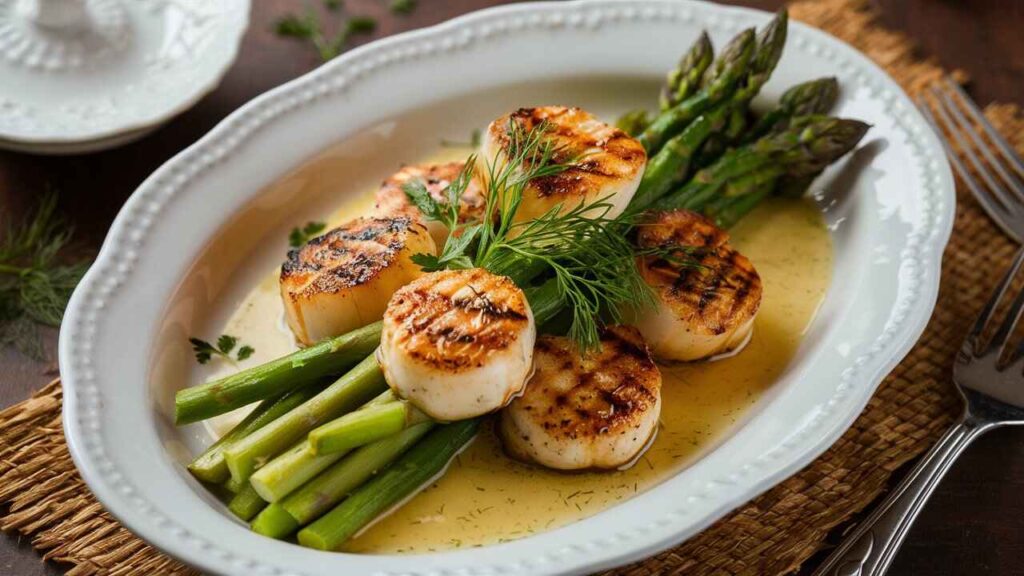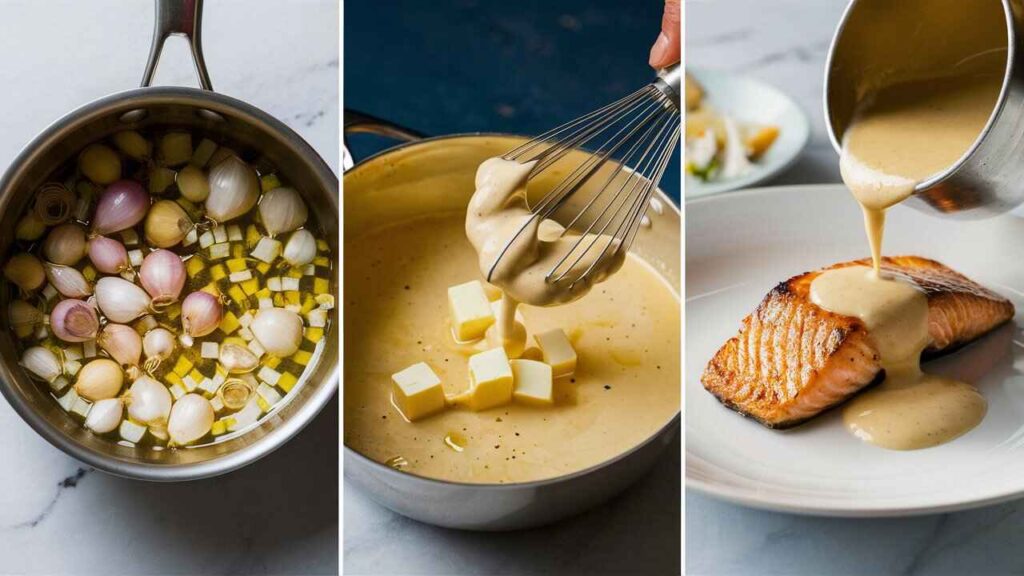Beurre blanc, a luscious butter-based sauce, holds a special place in French cuisine. Known for its velvety texture and tangy, aromatic flavor, it is a staple that enhances the taste of seafood, vegetables, and poultry. Many people wonder if it traces its roots to one of the classic “mother sauces” identified by the legendary Auguste Escoffier. This article explores the origins, characteristics, and preparation of beurre blanc while examining its connection (or lack thereof) to the five mother sauces.
Table of contents
The Five Mother Sauces of French Cuisine
To understand whether beurre blanc qualifies as a derivative of a mother sauce, we first need to explore what these mother sauces are and their importance in French cooking. Escoffier, the father of modern French cuisine, classified these five sauces as the foundational recipes from which many others stem:
- Béchamel: A smooth, creamy white sauce made from milk and thickened with a roux (butter and flour). It serves as the base for sauces like Mornay and cheese sauces.
- Velouté: A light, stock-based sauce thickened with a roux. It is typically made with chicken, fish, or veal stock and leads to derivatives like sauce allemande and suprême.
- Espagnole: A rich brown sauce prepared with brown stock, tomatoes, and roux. It forms the foundation for demi-glace and other bold-flavored sauces.
- Hollandaise: A warm butter sauce emulsified with egg yolks and flavored with lemon juice or vinegar. It is used as the base for béarnaise and other egg-based sauces.
- Tomato Sauce: A versatile sauce made with tomatoes, herbs, and sometimes stock or roux. This sauce serves as the backbone of countless recipes.
These sauces are referred to as “mother sauces” because they give rise to a family of secondary sauces. Each one plays a key role in French cooking.
The Origins of Beurre Blanc
Beurre blanc, meaning “white butter” in French, has its roots in the Loire Valley of France. According to culinary history, it was created by accident in the early 20th century. A chef named Clémence Lefeuvre, while preparing hollandaise sauce, reportedly forgot to add eggs to the mixture. Instead, she ended up with a butter-based sauce that was tangy and smooth. The resulting beurre blanc quickly gained popularity as a perfect pairing for the seafood caught in the Loire River.
For those exploring other buttery delicacies, our Ultimate Guide to Lemon Beurre Blanc offers a citrusy twist to this classic favorite.
Unlike hollandaise, beurre blanc is made without eggs. Instead, its creamy consistency comes from whisking cold butter into a reduction of white wine, vinegar, and shallots. This technique creates an emulsion, giving the sauce its characteristic silkiness.
Is Beurre Blanc a Mother Sauce?
The short answer is no. It’s not a derivative of any of the five mother sauces. While its butter-forward profile might make it seem similar to hollandaise, the two are distinctly different in both preparation and ingredients.
This white butter sauce does not rely on a roux or eggs for thickening, and it does not fit into Escoffier’s framework for mother sauces. Instead, it belongs to a category known as compound butter sauces. This means it stands alone as its own unique creation in the culinary world, celebrated for its simplicity and versatility.
Key Differences Between Beurre Blanc and Hollandaise
Although beurre blanc and hollandaise share some similarities, their differences set them apart:
| Characteristic | Beurre Blanc | Hollandaise |
|---|---|---|
| Base Ingredients | White wine, vinegar, shallots, butter | Butter, egg yolks, lemon juice/vinegar |
| Thickening Method | Emulsifies butter into reduction | Emulsifies butter into egg yolks |
| Flavor Profile | Light, tangy, aromatic | Rich, creamy, slightly tangy |
| Preparation Time | Shorter and simpler | Requires careful temperature control |
The two sauces serve different purposes but both bring richness and depth to dishes.
How to Use Beurre Blanc in Cooking
Beurre blanc’s delicate flavor and creamy texture make it an ideal choice for enhancing a variety of dishes. Here are some popular ways to use this sauce:
1. Pairing with Seafood
Beurre blanc’s acidity perfectly complements the natural sweetness of seafood. Drizzle it over seared scallops, grilled salmon, or poached halibut to elevate your dish.

2. Dressing Vegetables
Add flair to your vegetables by serving them with beurre blanc. Asparagus, green beans, artichokes, and roasted carrots all pair beautifully with this sauce.
3. Serving with Poultry
Lightly poached or roasted chicken breasts become extraordinary when topped with a warm beurre blanc. Its richness adds a touch of elegance to simple poultry dishes.
4. Using as a Base for Variations
Beurre blanc acts as a canvas for creativity. Chefs often experiment by adding herbs, citrus zest, or spices to create unique flavor profiles.
Beurre Blanc Recipe: Step-by-Step Guide
Here’s how to make classic white butter sauce at home:
Ingredients
- 1/2 cup dry white wine
- 1/4 cup white wine vinegar
- 2 medium shallots, finely minced
- 1 cup unsalted cold butter, cut into small cubes
- 1 teaspoon lemon juice (optional)
- Salt and white pepper to taste
Instructions
- Prepare the Reduction:
- In a medium saucepan, combine the white wine, vinegar, and shallots.
- Simmer over medium heat until the liquid reduces to about two tablespoons.
- Whisk in Butter:
- Lower the heat. Add one cube of cold butter to the reduction and whisk until it melts completely.
- Continue adding butter, one cube at a time, whisking constantly to create a smooth emulsion.
- Season and Serve:
- Once all the butter is incorporated, season with salt, white pepper, and optional lemon juice.
- Serve immediately over your dish of choice.

Tips for Beginners
Making beurre blanc might seem intimidating, but these tips will help you succeed:
- Use Cold Butter: Cold butter ensures a smooth emulsion and prevents the sauce from splitting.
- Control the Heat: Keep the heat low to avoid breaking the emulsion.
- Whisk Continuously: Constant whisking ensures a creamy, lump-free sauce.
- Serve Fresh: Beurre blanc is best served immediately, as reheating may cause it to separate.
Common Mistakes When Making Beurre Blanc
Even experienced cooks can encounter issues with beurre blanc. Here are some common mistakes to avoid:
1. Overheating the Sauce
Excessive heat can cause the butter to separate from the reduction, resulting in a broken sauce.
2. Skipping the Reduction Step
The reduction is crucial for building the sauce’s tangy flavor. Don’t rush this step.
3. Using Melted Butter
Always start with cold butter, as it helps stabilize the emulsion.
4. Reheating the Sauce
Beurre blanc doesn’t reheat well. Prepare it just before serving to maintain its texture.
FAQs
1. Can I make beurre blanc ahead of time?
It’s best to make it fresh, as it may separate when reheated.
2. What’s the difference between beurre blanc and beurre rouge?
Beurre rouge is made with red wine instead of white wine, giving it a deeper flavor and a reddish color.
3. Can I freeze beurre blanc?
No, freezing is not recommended because the sauce will separate when thawed.
Conclusion
Beurre blanc is a classic French butter sauce loved for its smooth, creamy texture and tangy, flavorful taste. Although it isn’t one of Escoffier’s five mother sauces, it holds a special spot in French cooking as a versatile and elegant topping for seafood, vegetables, and poultry. This sauce was born by accident in the Loire Valley when a chef forgot to add eggs to a hollandaise sauce. The mistake resulted in a rich blend of butter, wine, and shallots that quickly became a favorite. Its simple preparation, using only a few ingredients, makes it easy to make but still adds a touch of sophistication to dishes.
What makes beurre blanc timeless is its flexibility and ability to improve even the simplest foods. For example, its tangy flavor pairs perfectly with the natural sweetness of seafood, while its creamy texture makes vegetables and poultry taste even better. Even though its ingredients are basic, making beurre blanc requires careful attention and practice. Steps like keeping the heat low and whisking cold butter into the reduction are key to getting the smooth texture right. This sauce shows the beauty of French cooking—turning simple ingredients into something special. Whether you’re making a weeknight dinner or cooking for a celebration, this butter sauce not only makes your dishes more elegant but also ensures they stand out.

